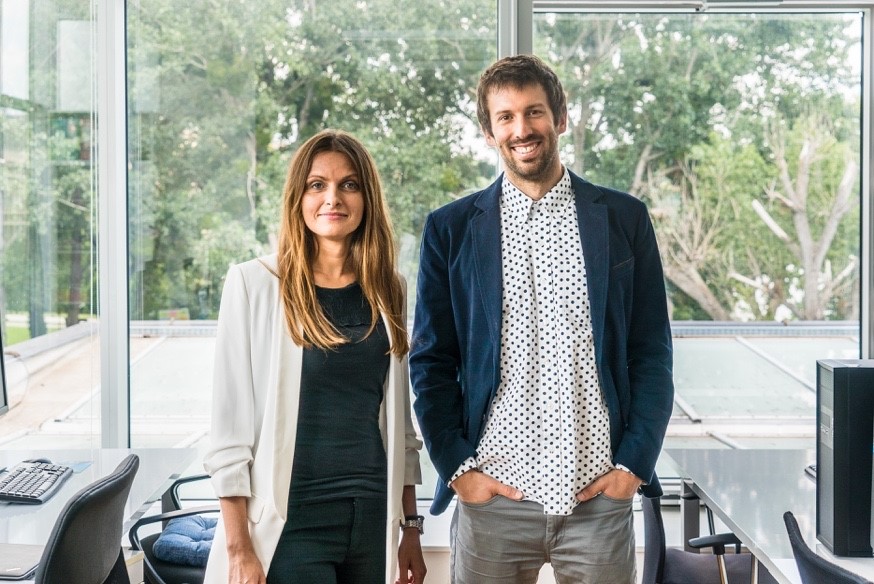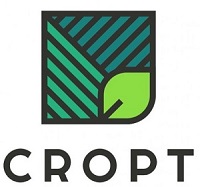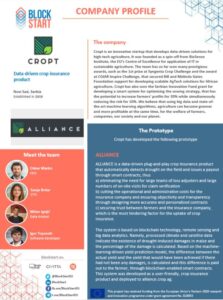Teaser of the company
Humanity is in need of innovative solutions to provide healthy food for its growing population. Cropt was founded with a clear vision to change agriculture, one of the most conservative and least digitised areas of industry. It believes that using big data and state-of-the-art machine learning algorithms, agriculture can become greener and more profitable at the same time, for the welfare of farmers, companies, our society and our planet.

Cropt has developed the following blockchain-based prototype in the scope of BlockStart:
ALLIANCE – AgricuLturaL InsurANCE
ALLIANCE was formed as an acronym of AgricuLturaL InsurANCE, but it is much more than that. It is a product that uses data and blockchain to ALLY the often conflicted sides, farmers and insurance companies.
ALLIANCE is a data-driven plug-and-play crop insurance product that automatically detects drought on the field and issues a payout through smart contracts, thus a) eliminating the need for large teams of loss adjusters and large numbers of on-site visits for claim verification b) cutting the operational and administrative costs for the insurance company and ensuring objectivity and transparency through designing more accurate and personalized contracts c) securing trust between farmers and the insurance company, which is the most hindering factor for the uptake of crop insurance.
The system is based on blockchain technology, remote sensing and big data analytics. Namely, processed climate and satellite data indicate the existence of drought-induced damages in maize and the percentage of the damage is calculated. Based on the machine-learning-driven yield prediction model, the difference between the actual yield and the yield that would have been achieved if there had not been any damages, is calculated and this difference is paid out to the farmer, through blockchain-enabled smart contracts. This system was developed as a user-friendly, crop insurance product and deployed to alliance.crop.ag. It is envisioned as a plug-and-play product, where the only integration that will be required is that with the company’s client database.
Technical development during Prototype stage
The technology developed within BlockStart is a prototype for a plug-and-play product for digital crop insurance. The prototype focuses on one peril, one region and one crop (drought/Serbia/maize). With a planted area of ~1.2Mha, maize is by far the most significant crop, with the country being in the top 10 list of global maize exporters. In the next phase of development, the system will be scaled to other perils, other regions and other crops. The year that was analysed is 2017, the last year in which drought was present.
Drought detection was based on two sets of parameters:
- Climate triggers: low precipitation and high temperature are the initial triggers for considering the drought in the region.
- Satellites triggers: Low NDWI (Normalised Difference Water Index) and EVI (Enhanced Vegetation Index) values. NDWI was developed with this particular purpose, to detect the absence of water in a field (threshold <0.2), while EVI is a general vegetation index that reflects the overall crop status (threshold <0.4).
Based on the satellite thresholds, segmentation of the satellite images was performed and regions that suffered drought stress were detected.
Cropt’s plan for the next 12 months is to incorporate other sources of risk in the system and to do a pan-European scale-up, where the product could be used anywhere in the EU without the need for additional calibrations.
The company already had negotiations with several agricultural and insurance companies and it plans to test the system with both its clients (insurance companies) and the final end-users (farmers). This will validate both the business model and the technical approach.
Business development during Prototype stage
Meet the Team

BlockStart allowed us to step into the world of blockchain-driven crop insurance, a futuristic concept that we always wanted to exploit, but never had the resources and appropriate support
Total funding received by Cropt d.o.o. under BlockStart: €16,000 (€1,000 for Ideation Kick-off and €15,000 for Prototype stage)





